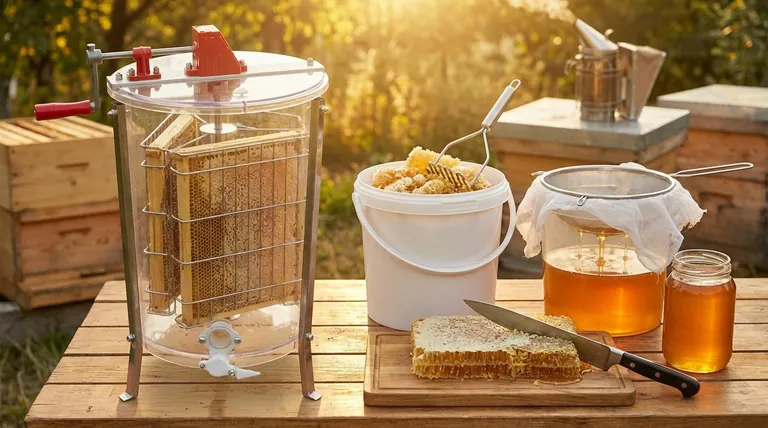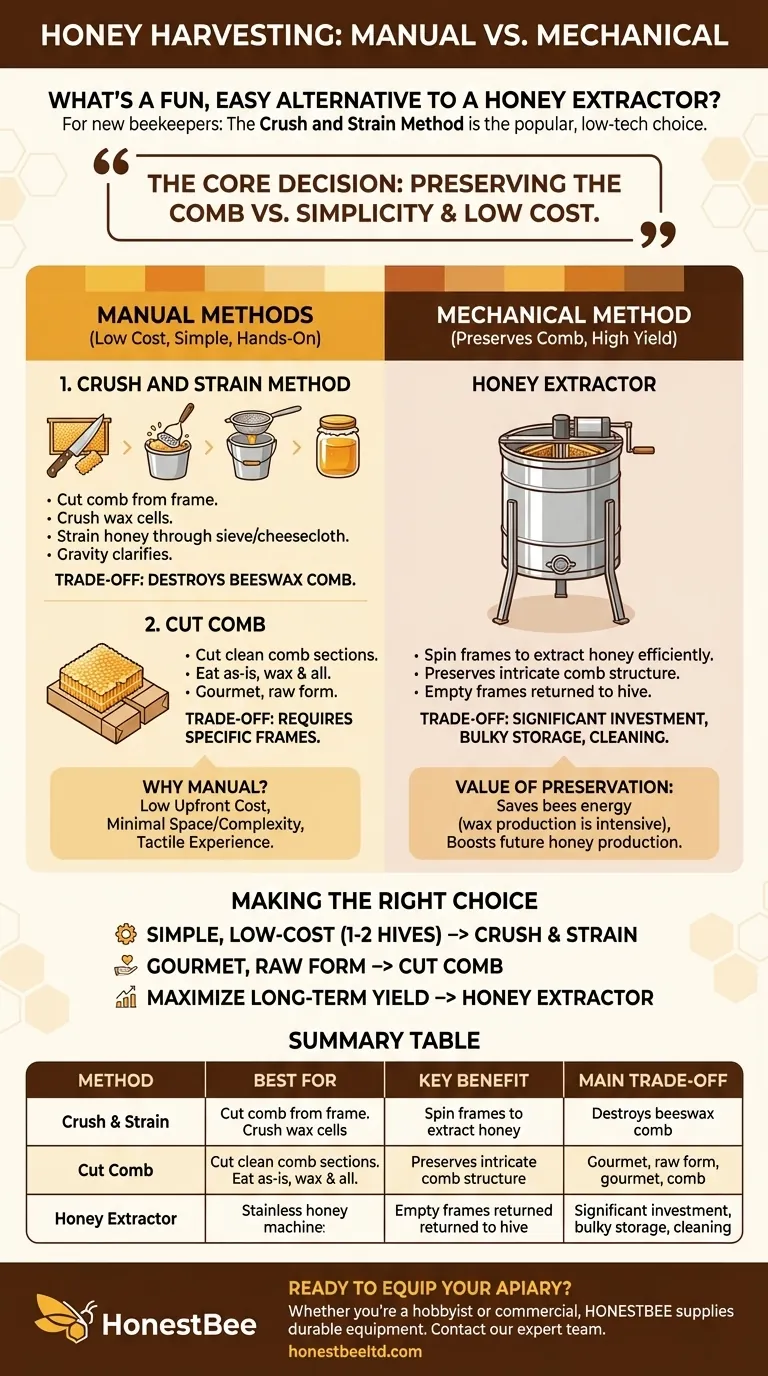For new beekeepers, the most popular and straightforward alternative to a honey extractor is the crush and strain method. This low-tech approach allows you to harvest honey from natural combs with minimal equipment, making it an accessible and engaging process for those with just a few hives.
The core decision between using a honey extractor and a manual method like "crush and strain" comes down to a single trade-off: preserving the beeswax comb for the bees versus the simplicity and low cost of the harvest.

Why Manual Methods Appeal to Hobbyists
For small-scale or first-time beekeepers, a large mechanical honey extractor can be impractical. The manual alternatives bypass the common barriers of cost, space, and complexity associated with this equipment.
The Upfront Cost
Honey extractors are a significant investment. A manual harvest requires little more than buckets, a knife, and some form of a sieve or cheesecloth, most of which you may already have.
Space and Complexity
Extractors are bulky pieces of equipment that require storage and a dedicated space for the messy work of harvesting. They also demand a thorough cleaning process to prevent the spread of bee diseases.
A More Hands-On Experience
Methods like crush and strain offer a tactile, direct connection to the harvest. For many, this hands-on process is a rewarding part of the beekeeping journey itself.
The Crush and Strain Method Explained
This method does exactly what its name implies. It is the ideal choice when working with foundationless frames or natural comb that you do not intend to reuse.
The Basic Process
First, cut the honeycomb out of the frame and place it into a food-grade bucket. Next, use a clean tool—like a potato masher or a large spoon—to crush the comb, breaking open all the wax cells.
Straining the Honey
Pour the mixture of honey and crushed wax through a strainer, sieve, or layers of cheesecloth into a second clean bucket. The honey will pass through, leaving the bits of wax behind.
Letting Gravity Do the Work
For the purest result, allow the strained honey to sit for a day or two. Any remaining fine particles of wax will rise to the top, where they can be easily skimmed off before bottling.
An Even Simpler Alternative: Cut Comb
If your goal is to enjoy honey in its most raw and unprocessed form, the cut comb method is the simplest of all.
What is Cut Comb?
This technique involves carefully cutting clean, square sections of capped honeycomb directly from the frame. These pieces are then packaged and eaten as-is, wax and all.
The Ideal Conditions
Cut comb works best when the bees have built their comb on frames with no foundation or on a special, extra-thin foundation designed for this purpose.
Understanding the Trade-off: Preserving the Comb
While manual methods are simple, they come with one significant downside: the destruction of the beeswax comb.
The Energy Cost to Bees
Producing wax is one of the most energy-intensive tasks for a honeybee colony. It requires a tremendous amount of nectar that could have otherwise been turned into honey.
The Value of an Extractor
The primary purpose of a honey extractor is not just to get the honey out efficiently, but to do so while preserving the intricate structure of the comb. The empty frames can then be returned to the hive.
Boosting Future Honey Production
By giving the bees their empty combs back, you save them the enormous effort of rebuilding from scratch. This allows them to immediately start refilling the cells, leading to a much larger honey harvest in the subsequent season.
Making the Right Choice for Your Goal
Your harvesting method should align directly with your beekeeping philosophy and the scale of your operation.
- If your primary focus is a simple, low-cost harvest for one or two hives: The crush and strain method is the perfect, low-barrier way to get your honey.
- If your primary focus is enjoying honey in its most natural form: The cut comb method offers a gourmet product with almost no processing required.
- If your primary focus is maximizing long-term honey production and minimizing bee labor: Renting or investing in a honey extractor to preserve the comb is the most strategic choice.
Ultimately, understanding how each method impacts your bees empowers you to choose the path that best suits your apiary.
Summary Table:
| Method | Best For | Key Benefit | Main Trade-off |
|---|---|---|---|
| Crush & Strain | Hobbyists, 1-2 hives | Low cost, simple setup | Destroys wax comb |
| Cut Comb | Gourmet, raw honey lovers | Minimal processing, pure product | Requires specific frames |
| Honey Extractor | Maximizing long-term yield | Preserves comb for bees | Higher upfront cost & storage |
Ready to equip your apiary for a successful harvest?
Whether you're a hobbyist starting with the crush and strain method or a commercial beekeeper scaling up with extractors, HONESTBEE has the reliable supplies you need. We supply durable beekeeping equipment and tools to commercial apiaries and distributors through our wholesale-focused operations.
Let us help you choose the right tools for your goals. Contact our expert team today to discuss your needs and streamline your beekeeping operation.
Visual Guide

Related Products
- HONESTBEE 3-Frame Manual Acrylic Honey Extractor
- Stainless Steel 3 Frame Manual Honey Extractor Spinner for Bee Honey Extraction
- 6 Frame Manual Stainless Steel Honey Extractor Beekeeping Equipment
- Plastic Hand Crank 2 Frame Honey Extractor Low Price
- electric honey extractor honey centrifuge 3 frame honey extractor stainless steel honey frame extractor
People Also Ask
- What size honey extractor do I need? Match Frame Capacity to Your Hives for Maximum Efficiency
- How to extract honey by hand? A Guide to Crush & Strain vs. Manual Extractors
- How do you manually extract honey? Choose the Best Method for Your Hive
- How often do beekeepers collect honey? Maximize Your Hive's Sustainable Yield
- What is the most common method for cleaning a honey extractor? Protect Your Honey & Equipment



















